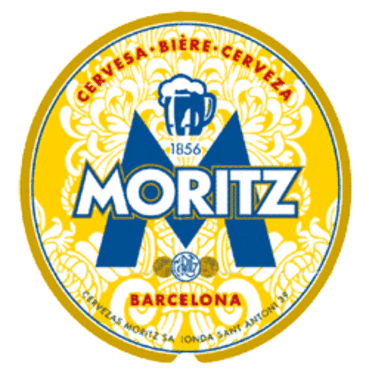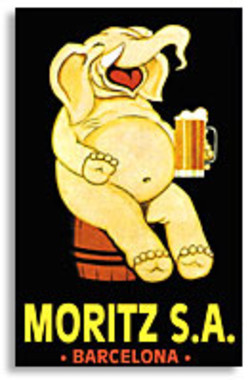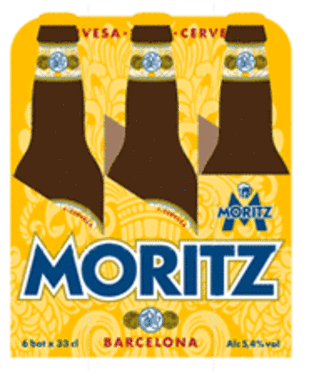Moritz: Another round
Brandchannel.com - March 27, 2006

Do enough eating, drinking or walking around in the food-crazed city of Barcelona and the signs are hard to miss: a big, blue “M” on a canary yellow background, announcing the return of Moritz beer to Spain’s Catalonia region. It’s a smart look that’s somehow both nostalgic and modern looking, which seems to be exactly the message that the recently relaunched beer brand wants to convey.
Originally the creation of an Alsatian brewer who swapped his native Alsatian taste buds for the Spanish—going from choucroute to suquet, one might say—Moritz first got going in 1856. Look at any company literature that follows its 2004 relaunch and it often seems like a catalog of its offerings for the past 150 years—good-looking stuff that still seems fresh and helps give the brand’s relaunch some instant credibility.
“It’s an old brand,” says Albert Castellón, general manager at Moritz. “It disappeared in 1978 when it was the most renowned brand in Barcelona,” but bad financial dealings brought about its downfall.
“But the brand has stayed in people’s brains,” he says. “This has helped us communicate our message.”
The Moritz website takes the nostalgia trip a step further. Even if your Spanish or Catalan is rusty or nonexistent, it’s a fun romp through world history that has little to do with beer, making hip jumps from subjects like Neil Armstrong’s walk on the moon to poking fun at Spain’s ex-dictator Francisco Franco.
Along with tradition and historical ties, the other major card Moritz is playing is its link to Barcelona, giving the city’s name marquee placement on its labels and marketing materials.

In Barcelona itself, the marketing goes even further. Tiny old Seat cars (natively manufactured in Spain), impeccably restored and decked out with a fresh coat of the company colors, turn heads as they dart across the city, spreading the word. Moritz is also in the process of refurbishing its old brewery in the city center. From the outside, the building’s façade is already a beautiful connection to town. Inside, the corporate offices, which occupy one side of the building, have the glaring fluorescent bulbs, blank white walls, and cheap new furniture of a recently-funded Internet startup, but the microbrewery it will soon open in the rest of the space will be another way to further cement its tie to the city.
“It’s a matter of brand here [in Spain] and people want to drink beer that has a relation with the region,” says Castellón.
In Spain, where much of the beer market competition comes from regional breweries, this creation of a strong local tie makes good sense. In Catalonia, where the Moritz brand is making its major push, it faces stiff, entrenched competition from the San Miguel brand and the near-ubiquitous Estrella Damm line of beers. Both competitor brands seem to prefer popularity to quality, which may open a different door for Moritz.
If you read between the lines in what Castellón says, it could be that Moritz may be dreaming of Estrella’s impressive numbers, but with the classier reputation of a microbrew. When Castellón mentions Estrella, it tends to be in terms of market share, but the models he seems to prefer are those of classier brews.
“I was in Cleveland a few months ago and Sam Adams was everywhere,” he says, clearly impressed with the American label’s progress from a Boston-based brew to a national success story.
Barcelona’s XiX Bar, a locals-centric café by day and hip bar with killer gin and tonics by night, seems so unimpressed with Estrella and San Miguel that it bucks the town’s trend and offers neither on tap.
XiX Bar’s co-owners Rosa Solà and Mike Cruickshank are impressed not only with the Moritz marketing efforts toward their clients, but also how the company works with the bars that serve its beer.
“I think they’re coming in [to the market] strong and deep,” says Solà .
“Estrella’s beginning to feel the pinch,” adds Cruickshank.
They’re also impressed with the company’s marketing efforts.
“C’est magnifique,” says Solà , employing a bit of the French touch. “They treat us very well and do a great publicity campaign.”

Moritz is also making strong inroads with XiX Bar’s clients. “We had some marketing signs up around the bar and people liked them so much, they stole them,” says Solà . She explains that another bar they own, Pescada Salada (“salty fishâ€), was one of the first places in town to stock the beer after it was re-released, and people would come to the bar just to try the new brew.
Across town, Cristina Jolonch, food writer for the magazine of La Vanguardia newspaper, believes that Moritz is running its re-entry to the market quite well.
“The main difference [between Estrella and Moritz] is that Estrella is very popular,” but does not put a big effort into quality, explains Jolonch. This “cut above†technique seems to extend beyond the taste of the suds. Estrella’s website looks downright corny next to the yellow-and-blue offering of its rival. A visitor to the Moritz site will stay because it strikes a balance of cool, whereas the Estrella site looks like, with enough rooting around, visitors might find offers for free stuff or pictures of girls in bikinis.
Jolonch is also optimistic about Moritz’s chances for long-term success. “I think it will work well. It tastes very good and they are marketing it very well. They are also doing a great job at getting it into the good restaurants.”
Sure enough, at the new tapas bar Inopia, run by Albert Adria—the pastry chef at his brother Ferran Adria’s famous three-star restaurant, El Bulli—there’s a sort of “Moritz corner,†with a booth set off in a section of the restaurant that sits under a wall-sized Moritz painting.
Along with Estrella and San Miguel, “The international brands… the ones that are a bit ‘premium’ – that’s where their big competition is,” says Jolonch. She mentions brands such as Corona (which curiously goes by “Coronita†in Spain) and Heineken.
If Moritz has its way, it’ll be a bit of both.
“I think [Moritz is] going to hit their stride in about five years,” says Jolonch. “It’ll be everywhere.”
Joe Ray is a freelance writer based in Paris. He can be reached via his website, www.joe-ray.com.